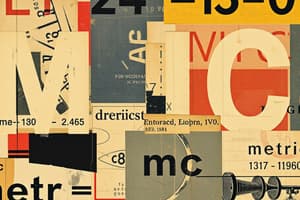Podcast
Questions and Answers
What is the fundamental unit of length?
What is the fundamental unit of length?
- Candela (cd)
- Kilogram (kg)
- Second (s)
- Meter (m) (correct)
What is the derived unit of force?
What is the derived unit of force?
- Watt (W)
- Newton (N) (correct)
- Joule (J)
- Ampere (A)
What does the prefix 'kilo-' represent?
What does the prefix 'kilo-' represent?
- 10⁻⁶
- 10⁻³
- 10³ (correct)
- 10⁻²
What type of uncertainty is the ratio of absolute uncertainty to the measured value?
What type of uncertainty is the ratio of absolute uncertainty to the measured value?
Which of the following digits is not significant in a measurement?
Which of the following digits is not significant in a measurement?
What is the fundamental unit of thermodynamic temperature?
What is the fundamental unit of thermodynamic temperature?
Flashcards are hidden until you start studying
Study Notes
Fundamental Units
- There are seven fundamental units in physics:
- Meter (m) - length
- Kilogram (kg) - mass
- Second (s) - time
- Ampere (A) - electric current
- Kelvin (K) - thermodynamic temperature
- Mole (mol) - amount of substance
- Candela (cd) - luminous intensity
Derived Units
- Derived units are formed by combining fundamental units:
- Velocity: m/s
- Acceleration: m/s²
- Force: N (Newton) = kg·m/s²
- Energy: J (Joule) = N·m = kg·m²/s²
- Power: W (Watt) = J/s = kg·m²/s³
Prefixes
- Prefixes are used to denote multiples and fractions of units:
- kilo- (k): 10³
- centi- (c): 10⁻²
- milli- (m): 10⁻³
- micro- (μ): 10⁻⁶
- nano- (n): 10⁻⁹
- pico- (p): 10⁻¹²
Measurement Uncertainty
- Measurement uncertainty arises due to limitations in measurement tools and techniques:
- Absolute uncertainty: the maximum possible error in a measurement
- Relative uncertainty: the ratio of absolute uncertainty to the measured value
- Percentage uncertainty: relative uncertainty expressed as a percentage
Significant Figures
- Significant figures (sig figs) represent the number of digits in a measurement that are known with certainty:
- Non-zero digits are always significant
- Zeros between non-zero digits are significant
- Leading zeros are not significant
- Trailing zeros are significant only if the number contains a decimal point
Studying That Suits You
Use AI to generate personalized quizzes and flashcards to suit your learning preferences.




